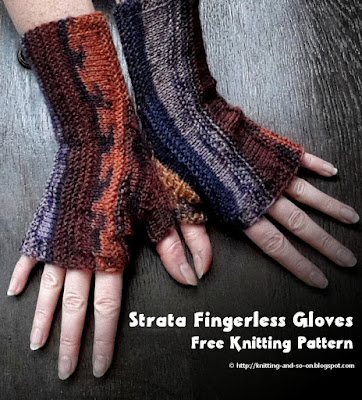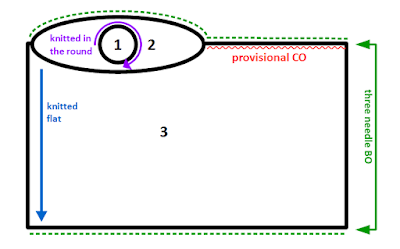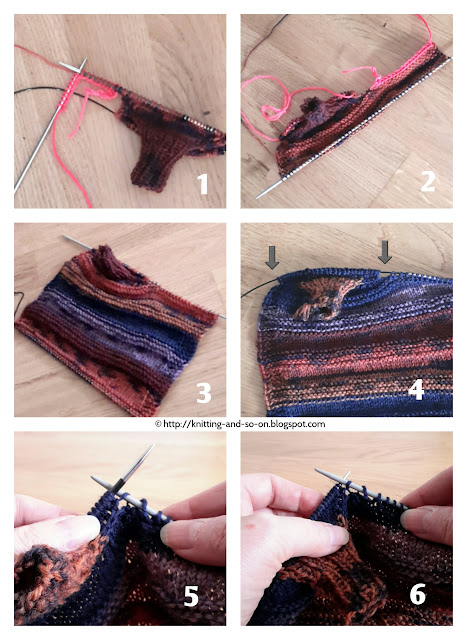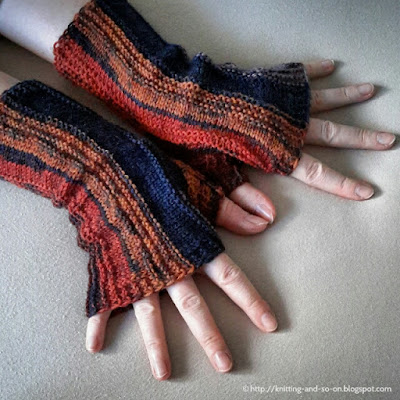I like the standard sock yarn that is available here in Germany and Switzerland. It usually has lovely color changes for great effects in a finished object. This looks nice when you're knitting a "normal" pair of loom-style fingerless gloves (i.e. stockinette in the round, top-to-bottom). But it can be more interesting if you use a different construction (as are for example
Circle Mitts,
Zoom Out Fingerless Gloves,
Pieces of Eight Mitts and
U-Turn Mitts on this blog). Here's a new pattern for fingerless gloves in a out-of-the-ordinary construction. They also are knitted in one part, i.e. there are only two ends to weave in per glove. Enjoy!
I'm usually bad at naming my patterns. So this time again I asked the good folk of
knittingparadise.com to help me out - you can read all their suggestions
here. I opted for "Strata" not only because of the stripes that are created by using a yarn with color changes but also because of the "structural stripes" given by the alternations of stockinette and garter stitch, This effect of parallel lines (one upon the other) changing in color and structure reminded me of
strata in geology. So I instantly loved the name. On top of that
"Strata" is also the name of a novel by my favorite author, Terry Pratchett.

This work by
Knitting and so on is licensed under a
Creative Commons Attribution-NonCommercial-ShareAlike 4.0 International License.


 Materials
Materials
- 3mm needles - I used dpns for the beginning (thumb) and circulars for the rest - however, except for the thumb the mitts are knitted flat, so for the main part you can use straight needles, too - as I did for the pictures :) - or you can use circulars if you do the beginning part (thumb) in Magic Loop method. Whatever methods or needles you use, you will need a third needle: a) for a provisional CO of new stitches right in the middle of the project and b) for a three-needle bind-off
- about 25 grams of fingering weight yarn
- scrap yarn for provisional CO and to be used as a "stitch holder"
- a crochet hook for provisional CO
- a tapestry needle to weave in ends
Techniques
Basic Construction
The schematic below shows the construction of these mitts. The mitts are started at the thumb (1) which is knitted in the round. Then an increasing oval shape is knitted (2) - half of the stitches of the oval are put on a stitch holder to be used later. At one end of the oval a provisional CO is added, to give length to the shaft of the mitts.
The main body part (3) is knitted flat. The last row is attached to the provisional CO and the stitches from the stitch holder by means of a three needle BO.
Gauge / Measurements
The finished mitts measure 21 cm in length, 15 cm in circumference at the top end and 18 cm in circumference at the bottom end - however, the pattern is written in a way that the circumference can be adapted.
When knitting stockinette stitch 13 sts gave 5cm in width and 7 rows gave 2 cm in height.
Instructions
Thumb
CO18
Rounds 1-10: *p1 k1 p1, repeat from *
Round 11: *p1 k1 p1 mk1, repeat from *
Rounds 12-15: *p1 k1, repeat from *
In row 15 either place two markers (one at the beginning of the round - the other at the middle of the row (i.e. after 12 sts)) or use the magic loop technique and distribute the stitches evenly on the front and back needle (12 sts each).
Rounds 16 and 17: * kfb, k to last stitch of this needle (or last stitch before marker), kfb, repeat from *
Rounds 18 to 21: *kfb, kfb, k to last 2 sts of this needle (or last 2 sts before marker), kfb, kfb, repeat from *
After round 21 you should have a total of 64 sts on your needles - these stitches now form an oval shape. For the body part only one side of this oval will be used.
Body
Row 1: kfb, knit to last stitch on this needle (or last stitch before marker), kfb - do a provisional CO of 18 new stitches on a third needle - then continue knitting these new 1 sts in row 1 (see picture 1).
Put the rest of the stitches on scrap yarn or on a stitch holder
Rows 2 to 4: sl1, k to end
(Rows 5 to 10 are basically stockinette stitch - except for the four stitches on the edges)
Row 5: sl1, k to end
Row 6: sl1, k3, p to last 4 sts, k4
Row 7 = Row 5
Rows 8+9 = sl1, k3, p12, w+t, k to end
Row 10 = Row 6 (picking up the wrapped stitch)
Row 11 = Row 5
Row 12 = Row 6
(Now your piece should look similar to the one in picture 2)
Rows 13-20: sl1, k to end (garter stitch)
Rows 21-26 = Rows 5 to 10 (stockinette stitch - except for four stitches on the edges)
Repeat rows 13 to 26 twice more - or until the mitt is wide enough to fit around your wrists.
Then knit four more rows of garter stitch (i.e. sl1, k to end).
Now prepare for joining the sides together with a three-needle bind-off.
Put the stitches from your scrap yarn/stitch holder on a needle as well as the stitches of the provsional CO. Your piece should now look similar to picture 3.
After you have picked up the stitches from the scrap yarn and your provisional CO, you'll notice two gaps (see picture 4). To avoid holes in the finished piece you'll have to pick up a stitch from these gaps and put them on the needle. To do this you need to transfer the stitches to a new needle - and when you reach the gap, pick up the the horizontal piece of yarn between the two stitches with your left needle (picture 5), and twist it (as in a mk1-sts). Now you have one stitch more which will help to avoid a hole. Do the same for with the last stitches of that row.
Now with right sides held together do a three needle BO. Weave in ends and turn the mitts back right sides out.













